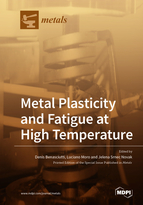Metal Plasticity and Fatigue at High Temperature
A special issue of Metals (ISSN 2075-4701). This special issue belongs to the section "Metal Failure Analysis".
Deadline for manuscript submissions: closed (30 November 2019) | Viewed by 41797
Special Issue Editors
Interests: structural integrity assessment; vibration fatigue; multiaxial fatigue; metal plasticity; finite element analysis
Special Issues, Collections and Topics in MDPI journals
Interests: multiphysics analysis, non-linear finite element simulations, failure analysis
Interests: cyclic plasticity; material characterization; thermo-Mechanical fatigue; non-Linear finite element simulations; nanoindentation
Special Issues, Collections and Topics in MDPI journals
Special Issue Information
Dear Colleagues,
The situation in which a component is maintained at high temperature under the action of cyclic thermal and/or mechanical loading represents, perhaps, one of the most demanding engineering applications, if not in fact the most demanding. Examples can be found in many industrial fields, such as automotive (cylinder head, engine, disk brakes), steel-making (hot rolling), machining (milling, turning), aerospace (turbine blades), and fire protection systems (fire doors).
The presence of high temperatures usually induces some material plasticity in the most stressed region of the system, which, combined with cyclic loading variation, may lead to low-cycle fatigue failure.
In order to estimate the component fatigue life in such demanding operative conditions, a complete characterization of the high-temperature material behavior under cyclic loading (e.g. cyclic stress–strain response, cyclic plasticity, fatigue testing under isothermal and/or non-isothermal conditions) should be performed. Moreover, a reliable structural durability approach, which includes experimental results in numerical and/or predictive models (e.g. plasticity models, fatigue strength curves), needs to be developed as well.
The choice of the most appropriate material model to be used in simulations, or even calibrating the model to experimental data, often represents the most critical step in the whole design approach. Experimental techniques and modeling have to be properly managed to guarantee the reliability of the estimated fatigue life.
The purpose of this Special Issue is to collect papers aimed at providing state-of-the-art knowledge on the topic of metal plasticity and the fatigue strength of metals operating at high temperatures, with an emphasis on both experimental characterization and the numerical modeling of material behavior. Researchers are encouraged to submit their research papers on specific aspects of high-temperature material behavior and fatigue strength, or also to describe specific applications in which the above-mentioned topics are applied to relevant engineering case studies.
Prof. Dr. Denis Benasciutti
Prof. Dr. Luciano Moro
Dr. Jelena Srnec Novak
Guest Editors
Manuscript Submission Information
Manuscripts should be submitted online at www.mdpi.com by registering and logging in to this website. Once you are registered, click here to go to the submission form. Manuscripts can be submitted until the deadline. All submissions that pass pre-check are peer-reviewed. Accepted papers will be published continuously in the journal (as soon as accepted) and will be listed together on the special issue website. Research articles, review articles as well as short communications are invited. For planned papers, a title and short abstract (about 100 words) can be sent to the Editorial Office for announcement on this website.
Submitted manuscripts should not have been published previously, nor be under consideration for publication elsewhere (except conference proceedings papers). All manuscripts are thoroughly refereed through a single-blind peer-review process. A guide for authors and other relevant information for submission of manuscripts is available on the Instructions for Authors page. Metals is an international peer-reviewed open access monthly journal published by MDPI.
Please visit the Instructions for Authors page before submitting a manuscript. The Article Processing Charge (APC) for publication in this open access journal is 2600 CHF (Swiss Francs). Submitted papers should be well formatted and use good English. Authors may use MDPI's English editing service prior to publication or during author revisions.
Keywords
- Structural durability
- Low-cycle fatigue
- High temperature
- Metal plasticity
- Material characterization
- Material numerical modelling
- Finite element method
- Failure analysis
- Cyclic material behavior







